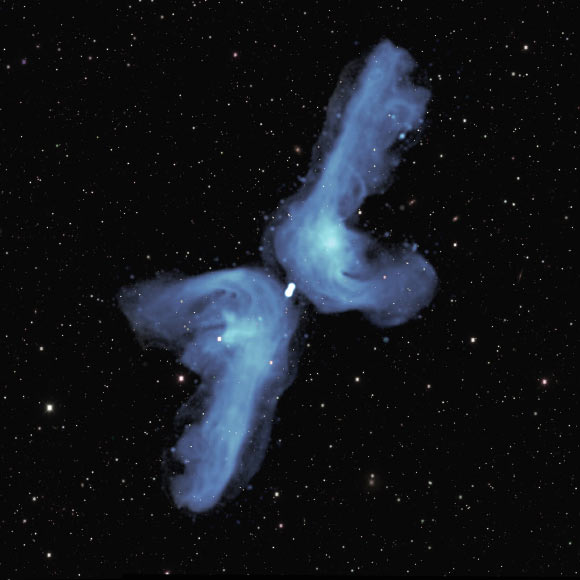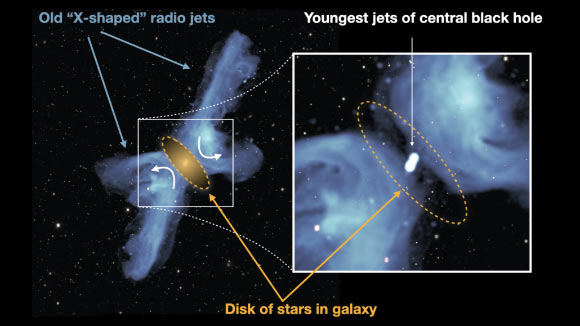Astronomers Crack Mystery of X-Shaped Radio Galaxies | Astronomy – Sci-News.com
Astronomers using the MeerKAT telescope at the South African Radio Astronomy Observatory in Cape Town, South Africa, have solved a longstanding mystery of X-shaped radio galaxies.

PKS 2014-55 is classified as ‘X-shaped’ because of its appearance in previous relatively blurry images. The detail provided in this radio image obtained with the MeerKAT telescope indicates that its shape is best described as a double boomerang. Two powerful jets of radio waves, indicated in blue color, each extend 2.5 million light-years into space. Eventually, they are ‘turned back’ by the pressure of tenuous intergalactic gas. As they flow back towards the central galaxy, they are deflected by its relatively high gas pressure into the shorter, horizontal, arms of the boomerang. The background image shows visible light from myriad galaxies in the distant Universe. Image credit: NRAO / AUI / NSF / SARAO / DES.
Many galaxies far more active than the Milky Way have enormous twin jets of radio waves extending far into intergalactic space.
Normally these go in opposite directions, coming from a massive black hole at the center of the galaxy. However, a few are more complicated and appear to have four jets forming an ‘X’ on the sky.
Several possible explanations have been proposed to understand this phenomenon:
(i) changes in the direction of spin of the black hole at the centre of the galaxy, and associated jets, over millions of years;
(ii) two black holes each associated with a pair of jets;
(iii) material falling back into the galaxy being deflected into different directions forming the other two arms of the ‘X.’
The MeerKAT observations of PKS 2014-55, an X-shaped radio galaxy located 800 million light-years away from Earth in the constellation of Telescopium, strongly favor the latter explanation as they show material turning the corner as it flows back towards the host galaxy.

This image of the X-shaped giant radio galaxy PKS 2014-55 indicates the old X-shaped radio jets, the younger jets closer to the central black hole, and the region of influence dominated by the central galaxy’s stars and gas. The curved arrows denote the direction of the backflow that forms the horizontal components of the X. Image credit: UP / NRAO / AUI / NSF / SARAO / DES.
“MeerKAT was designed to be the best of its kind in the world,” said study co-author Dr. Bernie Fanaroff, an astronomer with the South African Radio Astronomy Observatory.
“It’s wonderful to see how its unique capabilities are contributing to resolving longstanding questions related to the evolution of galaxies.”
“MeerKAT is one of a new generation of instruments whose power solves old puzzles even as it finds new ones,” said study lead author Dr. William Cotton, an astronomer with the National Radio Astronomy Observatory and the South African Radio Astronomy Observatory.
“PKS 2014-55 shows features never seen before in this detail which are not fully understood.”
The team’s paper was published in the Monthly Notices of the Royal Astronomical Society.
_____
W.D. Cotton et al. Hydrodynamical Backflow in X-shaped Radio Galaxy PKS 2014-55. MNRAS, published online May 7, 2020; doi: 10.1093/mnras/staa1240





